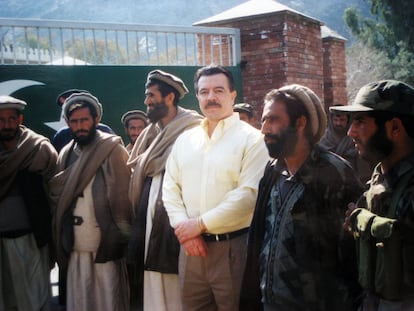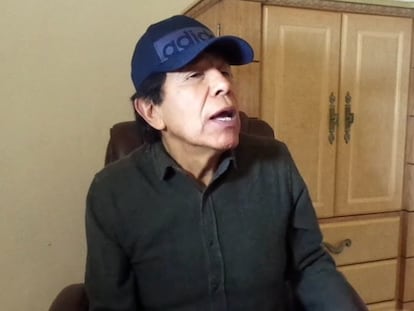Former DEA chief: ‘The Mexican Navy arrested Caro Quintero, but [we] gave them the intel’
Mike Vigil, ex-head of International Operations for the US Drug Enforcement Administration, spoke to EL PAÍS about the capture of one of the world’s most notorious drug lords


Mike Vigil worked for the US Drug Enforcement Administration (DEA) for more than 30 years, including a 13-year-long stint in Mexico. For much of his career, he investigated the Guadalajara Cartel, whose co-founder, Rafael Caro Quintero, had been a top target of law enforcement since he ordered the 1985 murder of undercover DEA agent Enrique Kiki Camarena.
Vigil is sure that, while Mexican authorities arrested Caro Quintero earlier this month, the DEA gave them the information. This is in direct repudiation of Mexican President Andrés Manuel López Obrador (AMLO), who denies that the DEA had any involvement in the operation. AMLO’s comments, meanwhile, contradict the US Attorney General and the Director of the DEA. Vigil notes that, in many cases, Mexican presidents do not even find out about the arrests of big capos until they have already occurred.
Question. Where were you when Camarena was murdered?
Answer. Camarena’s murder was in February of 1985. In October of 1981, I was transferred from Mexico to Medellin, Colombia. For a little over a year – due to threats from the Medellin cartel – the American ambassador decided to close the office. I went to Barranquilla, on the north coast of Colombia, where I took charge of that office.
When Camarena was murdered, we started a global investigation to bring members of the Guadalajara Cartel to justice. We began intercepting calls from a drug trafficker who had a residence in Cartagena, Colombia. One day, over the phone, he asked his housemaid if everything was ready because “the Lord” was coming. I traveled to Cartagena and we saw strange movements. I made the decision to raid the house in conjunction with the Colombian National Police. It was me and a colonel – we knocked on the door. The maid didn’t open up, but through a small window, we saw that Matta was there.
Q. Juan Ramón Matta Ballesteros, the Honduran narco who was the link between the Mexican and Colombian cartels?
A. Yes. We kicked down the door and Matta started running with a firearm, a nine millimeter. I chased him and when I was about to kill him, he told me: “Don’t shoot. Look, I know you’re from the DEA. Neither I nor my compadre had anything to do with the death of your agent. That was a marijuana thing.” That is, Caro Quintero.
Q. Did you take part in the undercover operation that Camarena was involved in?
A. I was no longer in Mexico when the operation began at the Búfalo Plantation in Chihuahua. But an informant of mine gave us the tip. Apparently, someone escaped from the ranch and met with the informant. He then went to the DEA to report that there was this huge marijuana plantation.
Q. What did you feel when you found out about the murder?
A. It was a tragedy. The saddest day at the agency.
Q. After the murder, a promise was made to capture Caro Quintero.
A. Yes, because if someone kills a DEA agent, we are going to look for him all over the world, with all the necessary resources and efforts. It’s very important to send the message to these drug traffickers that if they kill one of our agents, sooner or later, we are going to capture them.
Q. Was the agency satisfied when Caro Quintero was first arrested in 1985 and sent to jail in Mexico? Or were there always doubts that he could get out?
A. He was captured in Costa Rica. They deported him to Mexico and he was sent to a jail there. We were not satisfied, because at the time, he still had the criminal infrastructure to bribe and threaten officials in Mexico. He was sentenced to 40 years because he was the intellectual author of the murder. But, after 28 years, a state judge decided the federal government was not competent [in how they had prosecuted him] and ordered his release. But what was very strange to me was that the judge knew perfectly well that Caro Quintero had cases pending in the United States. They released him early in the morning. It was very suspicious.
Q. Do you think bribes were paid?
A. I don’t know, but it was really weird. For us, it was like an insult.
Q. What do you think about last week’s operation?
A. I congratulate the [Mexican] Marines, because they are the best of the best. They are heroes.
Q. There has been a bit of confusion, because both the US attorney general and the director of the DEA said that they collaborated in the operation. However, President López Obrador denies this. What do you think?
A. Of course [there was collaboration]. In Mexico, the security forces do not have the funds to recruit and pay informants. But the DEA does have those funds: for a long time, they have cultivated informants throughout the Republic. They have a lot of information and technology. For example, in the case of El Chapo Guzmán, they tapped cell phones to be able to locate the areas where individuals were hiding. In an operation like this, it’s the norm. The DEA did not go to Sinaloa to capture Caro Quintero, because López Obrador has also restricted the movements of the DEA a lot. Now, they can only pass on information. The Mexican Navy arrested Caro Quintero, but the DEA gave them the intel.
Q. Do you think that the arrest could have been carried out as retaliation [against AMLO’s administration] because of the Cienfuegos case, where Mexico’s former Secretary of National Defense was arrested by American officials in Los Angeles on drug and money laundering charges and then, upon extradition to Mexico, was released?
A. I don’t think so. Many people say that the arrest was the result of a meeting between López Obrador and Joe Biden that took place the previous week. But it doesn’t work like that. These things take a long time. That’s why I mention that there’s a possibility that he didn’t know that this operation was going to be carried out, because the Mexican presidents – at least, when I was in the DEA – often did not find out until after these operations were complete. They were not aware of every detail.
Q. But what is clear is that Caro Quintero was more of a target for the United States than for Mexico.
A. Yes, for us he was a very important figure, even though he was already washed up. But even so, the United States was offering $20 million for his capture. That’s much more than what was offered for the capture of Pablo Escobar or El Chapo.
Tu suscripción se está usando en otro dispositivo
¿Quieres añadir otro usuario a tu suscripción?
Si continúas leyendo en este dispositivo, no se podrá leer en el otro.
FlechaTu suscripción se está usando en otro dispositivo y solo puedes acceder a EL PAÍS desde un dispositivo a la vez.
Si quieres compartir tu cuenta, cambia tu suscripción a la modalidad Premium, así podrás añadir otro usuario. Cada uno accederá con su propia cuenta de email, lo que os permitirá personalizar vuestra experiencia en EL PAÍS.
¿Tienes una suscripción de empresa? Accede aquí para contratar más cuentas.
En el caso de no saber quién está usando tu cuenta, te recomendamos cambiar tu contraseña aquí.
Si decides continuar compartiendo tu cuenta, este mensaje se mostrará en tu dispositivo y en el de la otra persona que está usando tu cuenta de forma indefinida, afectando a tu experiencia de lectura. Puedes consultar aquí los términos y condiciones de la suscripción digital.
More information
Archived In
Últimas noticias
Welcome to the post-religion era: The idea of Christianity as the absolute truth has become obsolete
‘I thought you would like it’: The risky sexual practice popularized by TV shows and TikTok
The digitalization of tourism: ‘They promise experiences and gave us the worst possible one’
Mexican peso defies uncertainty with forecasts of a new period of stability in 2026
Most viewed
- Sinaloa Cartel war is taking its toll on Los Chapitos
- Reinhard Genzel, Nobel laureate in physics: ‘One-minute videos will never give you the truth’
- Oona Chaplin: ‘I told James Cameron that I was living in a treehouse and starting a permaculture project with a friend’
- Why the price of coffee has skyrocketed: from Brazilian plantations to specialty coffee houses
- Silver prices are going crazy: This is what’s fueling the rally










































